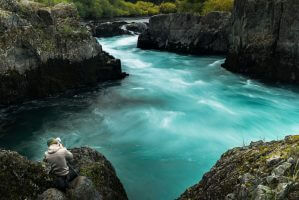Support Hidden Compass
We stand for journalism, science, history, and hope. Make a contribution to Hidden Compass and stand with us.
When I arrived in Kipwa, it was so hot I nearly threw up. It was February, in the middle of summer, just a stone’s throw from the equator, the heat so ferocious it steamed water in a Nalgene bottle, liquified cheese and chocolate, made me want to do nothing but lie down on a bouldering mat — anything other than go cragging.
I had driven two hours northeast of Kenya’s capital, Nairobi, to this village tucked away at the base of Mavoloni Mountain. The dozens of people who live in manyattas (thatched huts) here enjoy incredible views of the mountain. It was the middle of the dry season, and the shrubs that cover the undulating peaks were parched and brittle, but beautiful nonetheless.
Then I saw them. Two Americans wearing complementary blue-and-pink floral Hawaiian shirts, standing at the bottom of a steep rock face and admiring the fruits of their labor: dozens of bolts they’d installed over the past two days, twinkling in the mid-morning sun.
I’d come to meet these two scruffy Americans with dirty blond hair: Alex Zachrel — a former train-hopper from Boulder, Colorado, who was working as a guide for the Kenyan outdoor-education company Savage Wilderness — and his van-dwelling friend Michael Stahl.
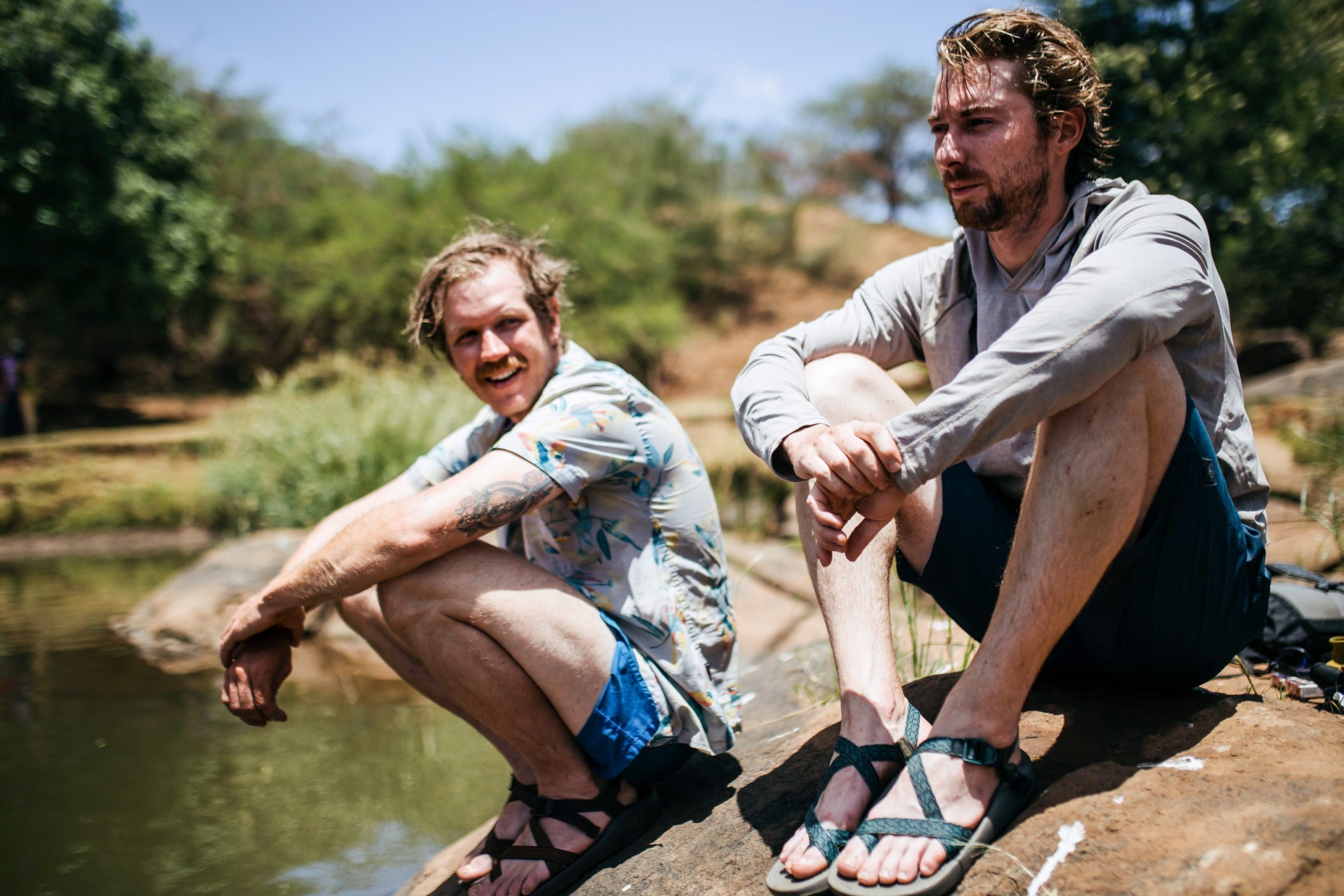
American climbers Alex Zachrel (left) and Michael Stahl want to help establish new sport climbing routes in Kenya. Zachrel says as outsiders, it’s important to be respectful and make sure they have the support of local communities, elders, and mzees (village leaders). Photo: Kang-Chun Cheng.
They’d met when they worked together in a climbing gym, then been COVID-19 roommates who passed the time by building a backyard climbing wall and “crack machine” — a piece of equipment that emulates the natural cracks in rocks into which climbers jam their fingers, hands, and feet.
Zachrel and Stahl were intent on establishing new “sport” climbing routes in Kenya, and had brought a lot of gear with them. Sport climbing involves drilling permanent anchors, known as bolts, into the rock so that climbers can clip in quickdraw carabiners, which their ropes can run freely through for protection throughout an ascent. Bolting a new route in Kenya is exciting, given that few sport climbs exist here, and news of Zachrel and Stahl’s trip had spread quickly through the country’s tight-knit climbing community.
Zachrel and Stahl had spent the past few days on the eastern ledge of Mavoloni Mountain, beneath a lone tree. “That was the best place,” Zachrel said. “We just had to be careful not to disturb the beehive there.”
I noticed the sweat dripping down their faces. It was only 8:30 in the morning. We looked at the brand-new route above us, a winding series of silver bolts zig-zagging up the near-vertical rock face, accentuated by trails of powdered rock where the anchors had been drilled in.
I complimented them on their Hawaiian shirts.
“First ascent day,” Zachrel said. “It’s a tradition.”
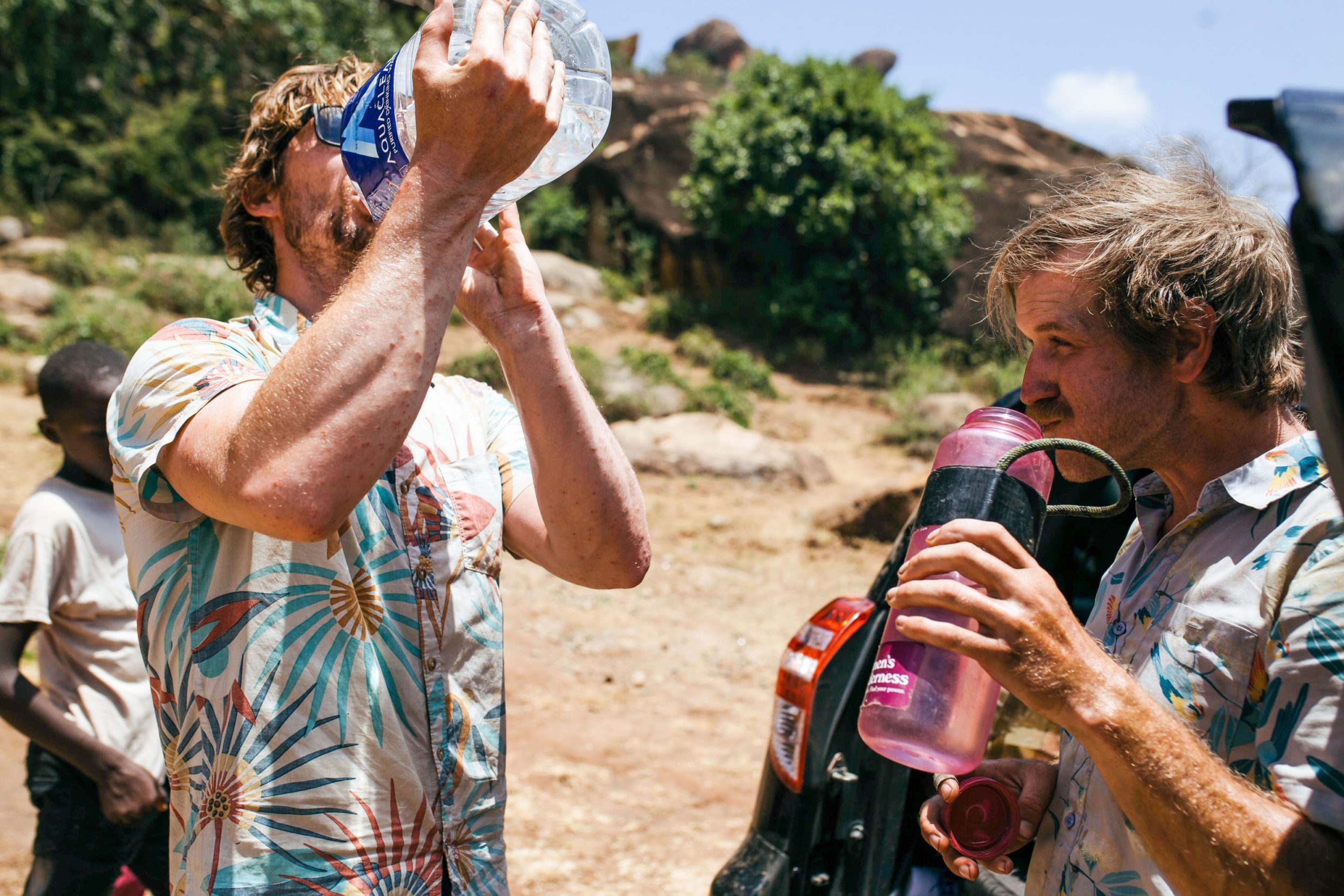
Zachrel and Stahl met as colleagues at a U.S. climbing gym, then passed the pandemic together as roommates building a backyard climbing wall. When they met up with photojournalist Kang-Chun Cheng, it was February, in the middle of summer, and the heat was ferocious. Photo: Kang-Chun Cheng.
~~
Rock climbing has existed as a sport in Kenya for the better part of century, but mostly as an activity for foreign visitors and expats. In recent decades, however, it has gained a foothold among locals — a development roughly in line with the sport’s global coming of age. In 2021, as climbing was featured in the Olympics for the first time (and the U.S. saw more climbing gyms open than ever before), conversations were under way in Kenya about how to make it accessible to more locals.
Kenya represents a sort of liminal space between the climbing establishment in the Western world and the resourceful scrappiness that characterizes climbing elsewhere in Africa. As Kenyans begin to embrace this sport — rock climbing is not yet officially recognized by the country’s Ministry of Tourism — national athletes are also trying to find their place, both as individuals and as representatives of Kenya within the global outdoor industry.
For me, Kenya and climbing are inexorably intertwined. This is where I really learned how to climb after years of fits and starts back home in the U.S. As I’ve made Nairobi my home over the past three years, Lukenya Hills, a popular weekend spot for city climbers, has offered me a consistency I didn’t know I’d been craving. Returning to Lukenya regularly has allowed me to develop an intimate relationship with the routes on Nemesis, one of four sport crags there.
“Leap of Faith” is the name of one tricky route that I climbed bolt by bolt (in sections). Another is called “As Good as It Gets”: After a scary fall on it last year, I got spooked for a while, but it’s since become one of my favorite climbs. And then there’s “Turbulence,” which I finally managed to surmount this summer after many futile attempts.
I can see how my climbing desire has shifted and softened over time. What began as an almost desperate compulsion to prove something to myself has become a means of connecting with a supportive group of fellow climbers. When I invite newcomers to join me at a crag, I want them to feel that shared sense of community and exploration.
~~
They would run and jump across the natural jungle gym, completely fearless as they tried to defy gravity.
Climbing is starting to gain traction in Kenya, Tyson Nuthu believes. But for the sport to really flourish here, locals will have to clear some steep mental hurdles.
Nuthu is a manager at Nairobi’s Climb BlueSky, the only climbing gym in East Africa. On a weekday afternoon in February, the 31-year-old and I were talking about the history of the sport in this former British colony, which won independence in 1963, after centuries of foreign exploitation. Its income, infrastructure, and ideology are still playing catch-up.
In some ways the development of climbing in Kenya mirrors the social rebellion that permeated the U.S. climbing community in the 1980s, before the sport really took off. During that era, climbing was practically countercultural — a magnet for misfits pushing back against cookie-cutter suburban life and square definitions of responsibility and productivity.
But in Kenya, layers of colonial history have muddled the debate about who climbing is really for.
“There’s still sometimes a social stigma that outdoor sports are for Westerners,” said Nuthu. Indeed, fewer than half of his gym’s regular clients are locals.
Nuthu pointed to entrenched cultural factors as one reason many Kenyans have been reluctant to climb. In a country where work is often risky or physically demanding — construction, mining — risking life and limb for a sport can be a hard sell.
“It’s common for parents to discipline their kids for climbing trees or doing anything that could hurt them,” Nuthu said. “And when you grow up with such rules, you’re conditioned to avoid anything like climbing.” Countering that message, he believes, will take time.
The same is true when it comes to mountain climbing, a close cousin of rock climbing. Sixty-two-year-old James Kagambi, who in May became the first Kenyan to summit Mount Everest, remembers the days when he was the only Black Kenyan member of the Mountain Club of Kenya.
“It didn’t bother me — I knew that it would take time for the demographics to balance out,” he said, a week after returning from the groundbreaking expedition. “Plus, so many mountaineers were extremely supportive of me.”
~~
Climbing etiquette holds that the first person to climb a new route — the first ascensionist — gets to name it. Zachrel and Stahl had a name in mind for the route they’d installed at Kipwa: Tupande Pamoja. It means “Let’s Climb Together” in Kiswahili, one of Kenya’s many languages, and is also the tagline of the organization Climbing Life Kenya (CLK).
Since they’d arrived in Kenya, Zachrel and Stahl had become fast friends with Liz Ndindi and Nyamzy Giati, the female co-founders of CLK. Ndindi is a mother with a background in quantity surveying. Giati holds a degree in agroecosystems and environment management. Both are soft-spoken, with a sort of calm intensity that mirrors their climbing styles.
After becoming climbing buddies, in 2018, they realized they shared a desire to help develop the local climbing community. Headquartered in Nairobi, CLK offers group and individual climbing classes that teach newbies crucial skills and techniques.
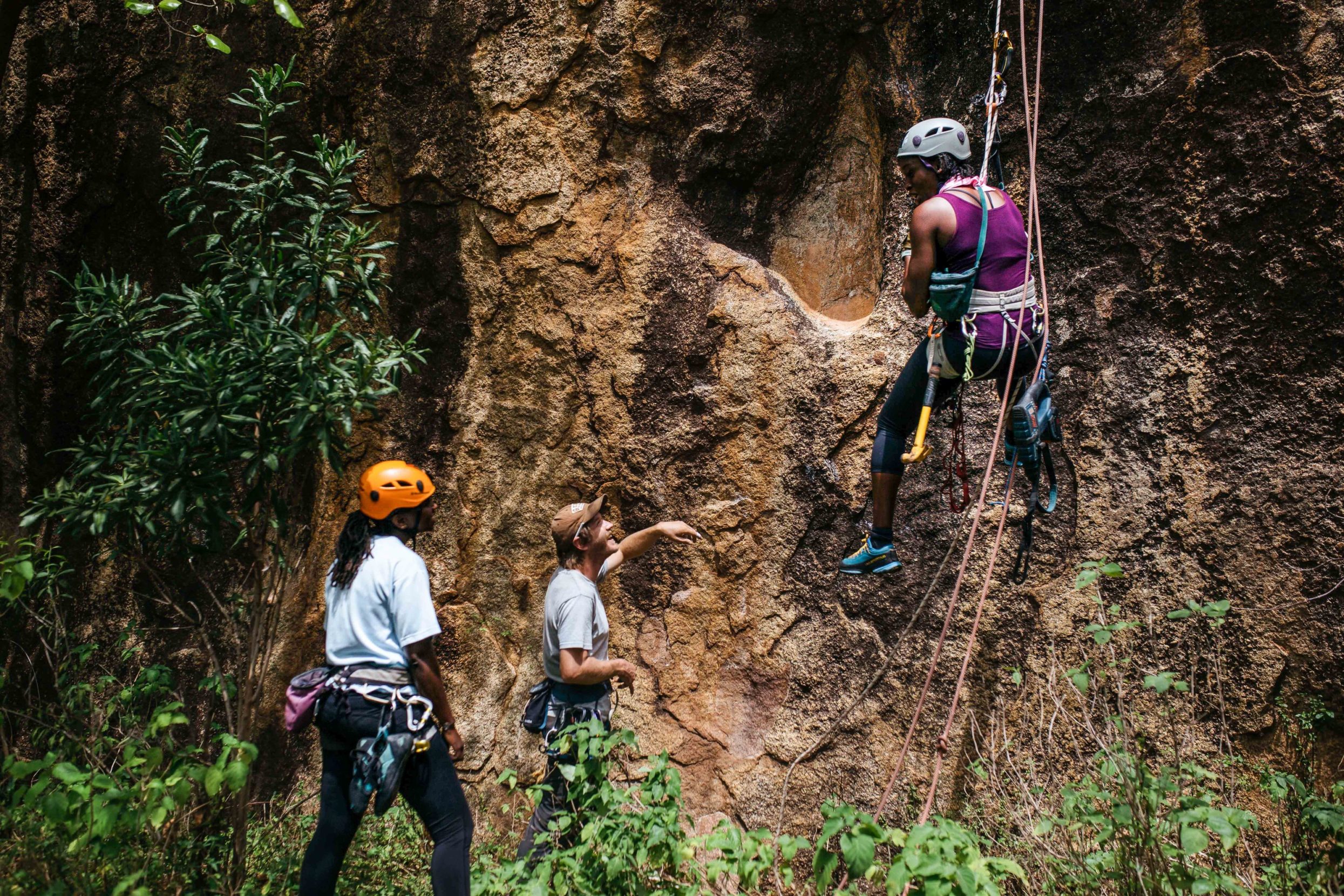
Zachrel and Stahl have found kindred spirits in Nyamzy Giati (left) and Liz Ndindi (on ropes), the co-founders of Climbing Life Kenya (CLK). The Nairobi-based organization offers classes that teach novices crucial climbing skills and techniques. Photo: Kang-Chun Cheng.
I met Ndindi and Giati while climbing at Lukenya on a crisp October day. The coldness of the sharp rock made it feel like it was cutting into our fingers with more force than usual.
“I like the way you move,” Ndindi told me. “But you need to climb more like a girl! Use more balance and flexibility.”
It was true that I’d climbed mostly with guys to that point, the result of circumstances and partner availability, not choice. But her constructive assessment made me want to spend more time with these two women, and tap into a side of myself that I’d unwittingly been neglecting.
“We have a holistic mission: to empower people to feel invested in the sport, on their own terms,” said Ndindi. Which means that CLK meets individuals where they are. “Whatever their background, age, physical ability, climbing style, or preference — they have a place with us.”
Just then a group of curious local kids arrived. Zachrel and Stahl had already befriended the little gang, for whom the Kipwa rocks were a playground — one their parents probably didn’t know about. They would run and jump across the natural jungle gym, completely fearless as they tried to defy gravity. They had their own naturalistic names for the rock formations — which climbers call crags — such as Ikuyu Inene, or “Big Fish.”

For these two boys and their friends, the Kipwa rocks are a playground — one their parents might not approve of. “It’s common for parents to discipline their kids for climbing trees or doing anything that could hurt them,” says Tyson Nuthu, a manager at Nairobi’s Climb BlueSky gym. Photo: Kang-Chun Cheng.
Now they would all climb the new bolted route together. Stahl fitted one eager-looking boy — a 10-year-old named Jeff, the leader of the little band — with a climbing harness. It was a bit too big for the boy’s slender frame, but secured with some extra carabiners, it would do. The harness attached Jeff to a rope that was secured to an anchor that Zachrel and Stahl had drilled in at the top of the climb.
Stahl raced to feed Jeff rope as the boy ascended the rock. The sneakers he wore, rather than proper climbing shoes with special, grippy rubber, didn’t seem to slow him down. He scampered up the rock like a pro. When he was lowered back down to the ground, we all cheered.
“You’re one of the first ones up there!” Stahl said. “Well done!”
Jeff beamed ear to ear.

Wearing a climbing harness with extra carabiners to secure his slender frame, a bold 10-year-old boy named Jeff ascends the crags at Kipwa. Photo: Kang-Chun Cheng.
At that point the swelter became too much; it was simply too hot to climb. The heat from the rocks had penetrated my shoes, and my toes were burning. We made the unanimous decision to head to a nearby stream to swim, cutting across cropland and through the shrubby forest.
Jeff led the way.
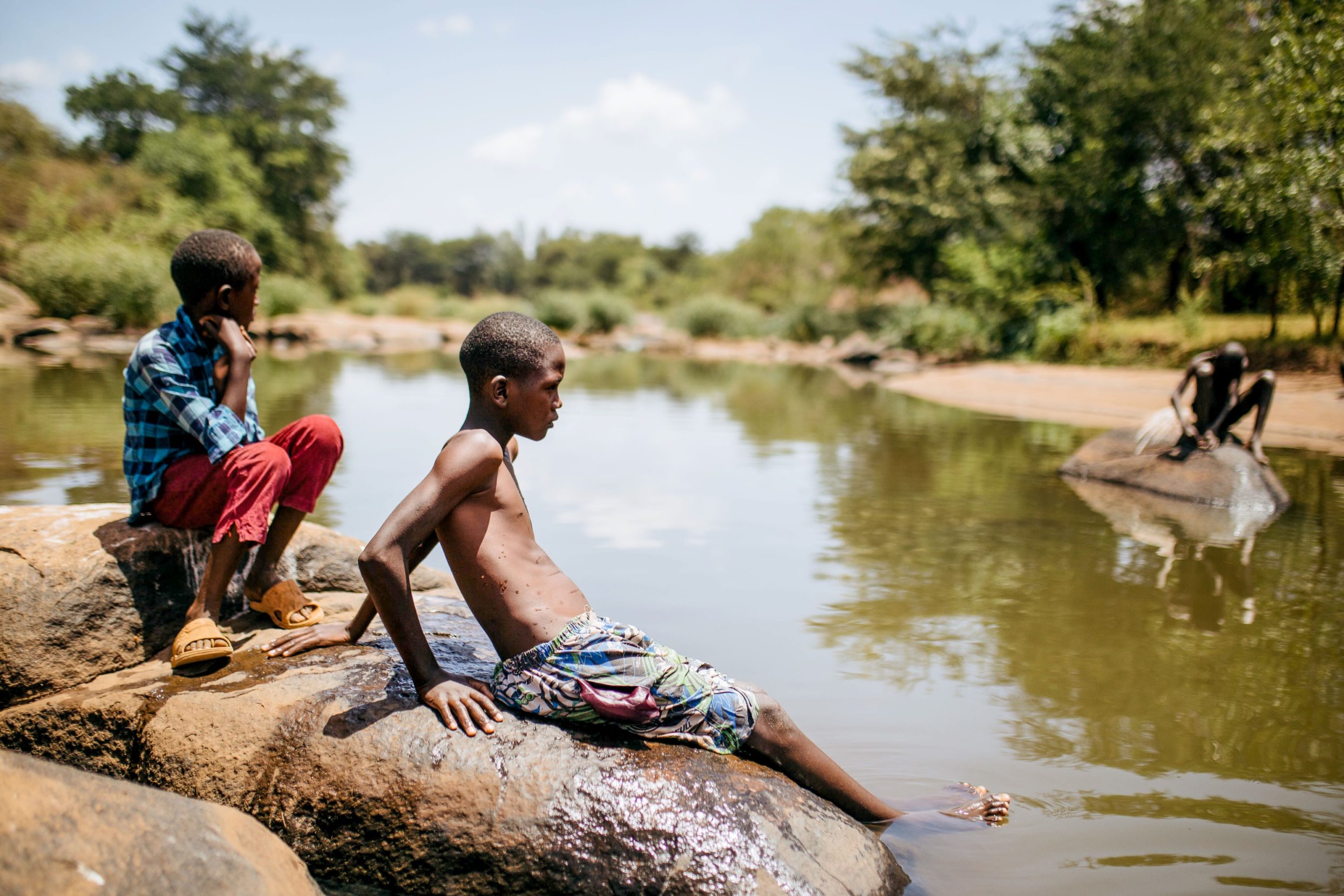
The swelter of a Kenyan summer, just a stone’s throw from the equator, can be brutal. When the heat from the climbing rocks penetrates shoes and scalds toes, a stream to swim in can be just the thing. Photo: Kang-Chun Cheng.
Zachrel, who came to Kenya as an outsider, believes it’s crucial to get local communities on board with the idea of people climbing up and down their rocks. That’s one reason he and Stahl have spent a lot of time hanging around Kipwa and playing with the kids. They wanted to be respectful, foster goodwill, and forge productive ties with locals.
“We needed to chat with the mzees (village leaders), the people owning adjacent farms, and get blessings from the elders,” said Zachrel. He showed me a video of Jeff and the crew strumming his guitar. “They did that for hours, until we had to pack things up.”
Expats in Kenya haven’t always gone about things that way. Rajal Upadhyaya, a climber born and raised in Nairobi, remembers when the late American climber Todd Skinner visited Mount Poi in 2000 and bolted a bunch of routes without consulting the locals. A notable climbing route that Skinner and his crew established was called “Dark Star Safari,” according to an excerpt from that year’s American Alpine Journal.
“They hired a bunch of porters to carry up all their gear and water,” Upadhyaya told me recently as we drove back from Lukenya after a luxurious half day of midweek climbing. “It was a big event. But the bolting pissed a lot of people off. It comes from an American or Western arrogance and assumption that Kenyans wouldn’t care. Imagine going to Yosemite and bolting it up. There would be an uproar!”
~~
On a Thursday afternoon at Climb BlueSky, just before the evening crowd arrived, the gym was nearly empty.
BlueSky is a small facility, not as well equipped as other climbing gyms in other countries. But for me and others here, it’s a haven from the pandemonium of Nairobi. Six floors below, in the Kenyan-Indian neighborhood called Parklands, the streets teem with produce vendors, boda bodas (motorbikes), and lorries that frequently break down in the middle of the street.
Whenever I have a break between reporting trips, I try to come to BlueSky a few days a week. It’s an oasis of consistency and community — a place to think things over, work on my conditioning, plop down on the bouldering mats and decompress from all the little stresses of the day, or chat with fellow climbers and gym employees who have become friends.
One of them is Richard Ahaza, a local climber who’s worked here for over a decade. As he belayed me on one of dozens of top-rope routes, we talked about a schism in the climbing community.
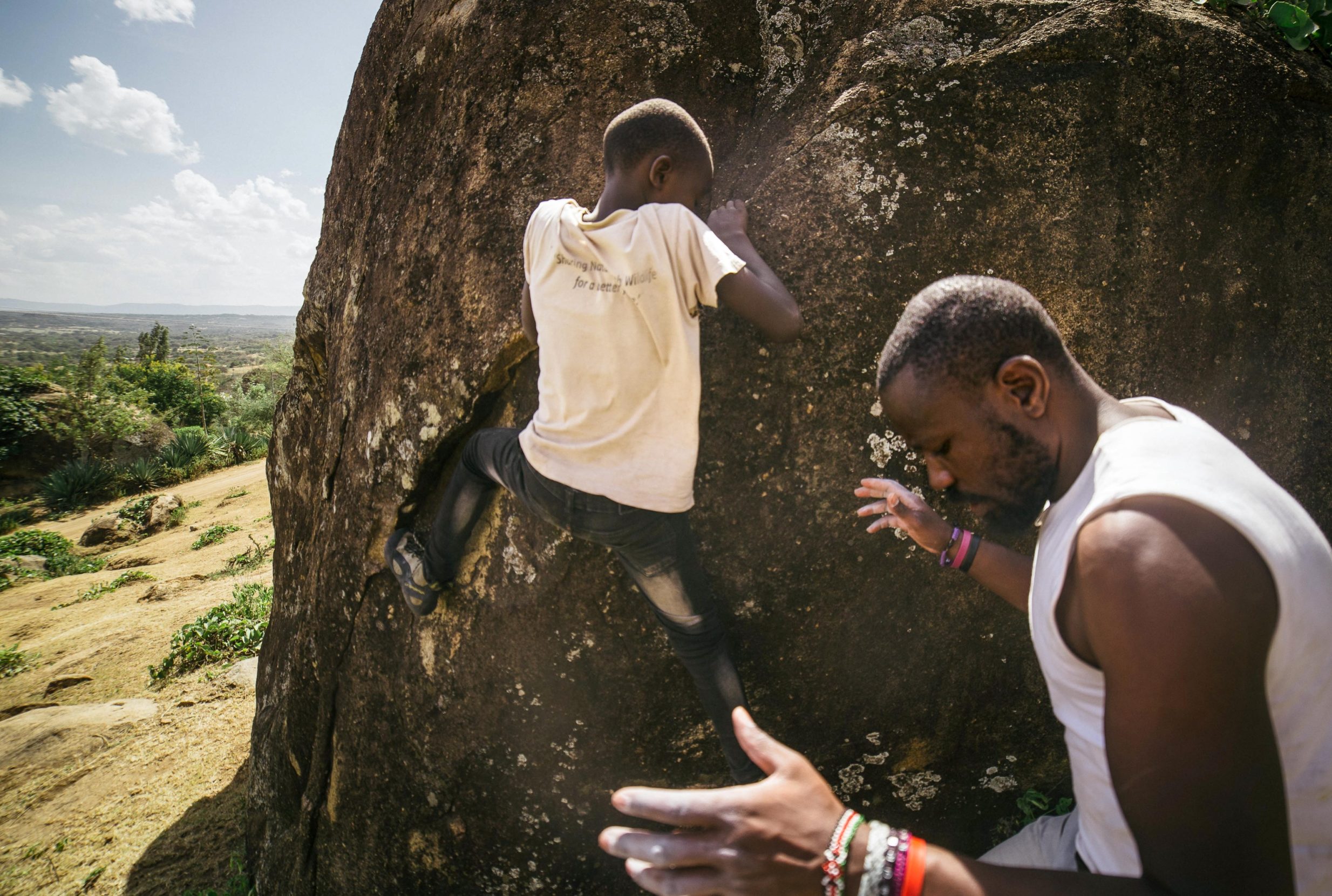
Local climber Nelson Anyanzwa advises a newbie on his next move. Photo: Kang-Chun Cheng.
“Trad,” or traditional, climbing is the purist’s form of the sport. A highly mental enterprise, it involves a lead climber carrying and placing temporary, removable gear into natural slots in the rock (rather than putting permanent bolts into crags), as well as slow, careful, safety-first progress that depends on the skill of finding routes in the rocks as you go.
By contrast, sport climbing — the kind that Zachrel and Stahl were promoting in Kipwa — focuses almost exclusively on the physical challenges, as the climber follows and clips into a route of preplaced bolts. Unlike trad climbing, which is nearly always done outside on real rock, sport can be practiced in a climbing gym. And while trad gear is designed for comfort and technique, sport harnesses and shoes are optimized for style and speed.
Trad is, as the name implies, the older, more traditional form of climbing. Sport came on the scene in the 1980s. Since then, the divisive “to bolt or not to bolt” debate has vined across the global climbing community. Both forms have their merits, says Ahaza.
“There’s a greater sense of adventure” with trad climbing, he said as he lowered me from a slight overhanging route, because the climber isn’t confined to pre-bolted routes that others have developed. “Theoretically, you could climb anywhere. You have the freedom to explore more of the country through trad.”
But Ahaza recognizes that in Kenya, trad climbing will need more time to appeal to novice climbers. It has a steeper learning curve than sport climbing — you need more gear, plus the knowledge to use it all safely — and it’s scarier, he said. Sport climbing is considerably easier for beginners, and mentally more comfortable.
There’s currently nowhere in Kenya to buy a new trad rack (a full set of cams and nuts), which would be prohibitively expensive for many newbies anyway — up to $2,000 (USD), in a country where the median monthly salary is a fraction of that amount. The French company Decathlon only recently started selling climbing shoes and quickdraws in Nairobi — the only place in East Africa that sells climbing gear of any kind.
Many expats, myself included, use family visits as an opportunity to stock up on climbing equipment.
~~
Climbing ethics and best practices vary from country to country, depending on local rules, traditions, and geology. For instance, the use of chalk to get a better grip is forbidden in many parts of the Czech Republic, to conserve that country’s delicate sandstone.
In Kenya, trad climbing is more common, because the rock here — whether it’s the slippery igneous rock of Hell’s Gate National Park (the inspiration for the Lion King) or the jagged peaks at Dragon’s Teeth, which rise from wet moors and bogland in the Aberdares — has an abundance of natural features that are perfect for placing cams and nuts.
This style of climbing is both practical and philosophical. It accords with a purist’s preference for minimalism and keeping things authentic, unaltered, the way they’ve always been — which aligns broadly with the global Leave No Trace outdoor recreation ethic. It’s the old-school way of doing things — think men summiting the Eiger in wool knickers and a rope tied around their waists.
The first substantial wave of climbers in Kenya arrived in the 1950s. They were mostly expats or white Kenyans of European descent, called Kenyan Cowboys (KCs) — those with the time, access, opportunities, and resources to climb. KCs imported their British climbing ethic to the Kenyan backcountry, and were the main driving force here until the end of the 20th century.
In a country where work is often risky or physically demanding — construction, mining — risking life and limb for a sport can be a hard sell.
Parag “Fish” Shah represents a new breed of Kenyan climber. A local climber, he has bolted routes across Kenya’s wonderfully diverse geological formations, from the Precambrian gneiss at Lukenya (a site of archaeological significance dating to the Late Stone Age) to the granite of Mount Ololokwe (a 6,000-foot-tall mountain that rises from the desert plains in Kenya’s far north and has been a sacred site for the Indigenous Samburu people since time immemorial).
Shah thinks that as climbing in Kenya grows apace, more bolted sport routes will appear, and the old-school preference for trad will fade as Kenya’s climbing community continues to evolve and people become more laissez-faire.
Peter Naituli agrees. The 23-year-old is one of Kenya’s most promising young climbers and mountain guides. When I spoke with him in Nairobi in late May, he said he was happy to be in the city for a few days after weeks of guiding clients up Mount Kenya, Africa’s second-highest Afro-Alpine peak.
Like Shah, Naituli, an elite climber who also teaches beginners, doesn’t get the philosophical fuss of the bolting debate.
“There’s a lot of rock in Kenya, many cliffs that are in the process of being discovered,” he said. “You can find routes for everyone and still follow old-school ethics to some extent.”

The crags of Kenya have an abundance of natural features that are perfect for climbing. The country’s diverse geological formations include the Precambrian gneiss at Lukenya and the granite of Mount Ololokwe, a 6,000-foot-tall mountain in the far north. Photo: Kang-Chun Cheng.
~~
A few months after that blazing February climb, Zachrel was back in Kipwa.
It was April now, so markedly cooler. This time Ndindi and Giati were there too, to learn how to bolt routes themselves. That’s how they found themselves taking turns hanging from a top rope off a vertical section of rock, wielding a bulky drill gun. It was time to use all the climbing gadgets that Zachrel and Stahl had schlepped over from the U.S.
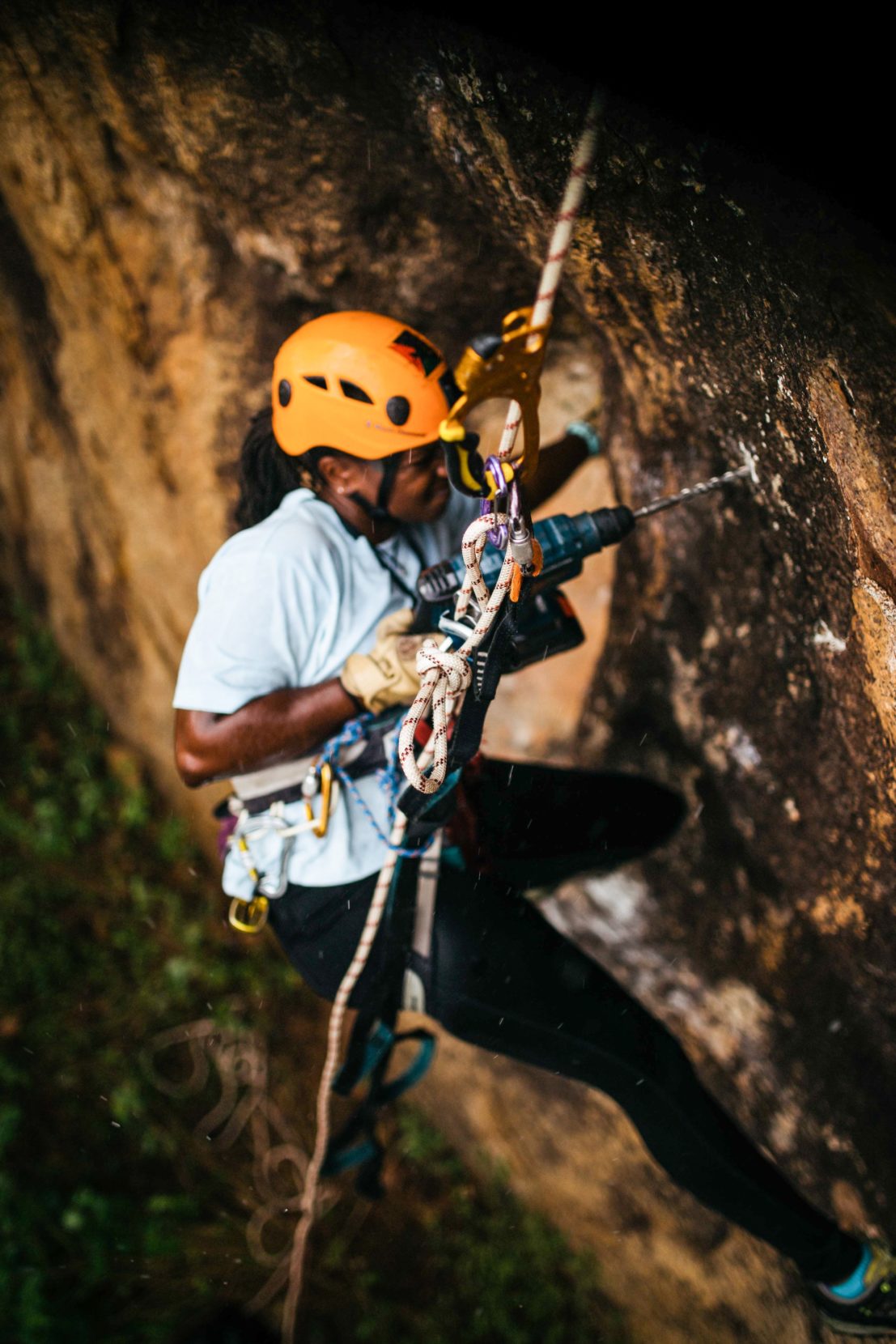
Giati wields a drill gun as she bolts a route for the first time, hanging from a top rope at Kipwa during a downpour. Photo: Kang-Chun Cheng.
Sporting a tangerine-colored helmet, Giati was juggling several things at once: keeping her balance, jumaring upward (ascending the rope with a rigging system), and finding natural resting places on the rock for grip so that she could drill in bolts for a new route. Zachrel coached her from the base, offering encouragement as Giati wrestled her way up.
“Looking good!” he called out, as she tugged the gun from its holder on her harness, preparing to drill the rock. “You’ve got this!”
Suddenly the sky opened up, and water started pouring down, as it often does in April in Kenya. Ndindi and Zachrel took cover beneath some trees and overhanging rock. Giati remained on the wall, resolute in her mission to climb it.
I was also stranded, hanging on a top rope adjacent to Giati, trying to get good pictures of her bolting the route. I didn’t want to stop, even though the heavy sheets of rain soaked through everything, including my camera — despite my flailing efforts to protect it with a soaked shirt. Slight panic set in as the control panel went haywire.
“Are you having fun yet?” Ndindi joked, as water streamed off her helmet. Giati retorted that she certainly was — and so were the Kipwa kids, who stumbled over one another in their excitement to watch what we were trying to do. We must have looked pretty ridiculous with all of our jangling gear and bags stuffed with equipment amid the chaos of the rain.
A few minutes later the downpour ended, just as suddenly as it had started. I put my trusty Canon in a hot car to dry off. Miraculously, all the buttons resumed operating.
We laid our soaked clothing out to dry, then ate bread and jam in the gentle sun. There would be plenty of time that day to finish bolting and testing the route.
Zachrel handed his binoculars to Jeff, who zoomed off to scramble up a boulder, playing detective with a group of the other kids. A few who weren’t sleuthing were using a long stick to scrape honey from a beehive (not the one Zachrel and Stahl had camped beneath), giggling as they squabbled over the cache. When we headed back to the main road, the kids dropped the stick and trooped along with us.
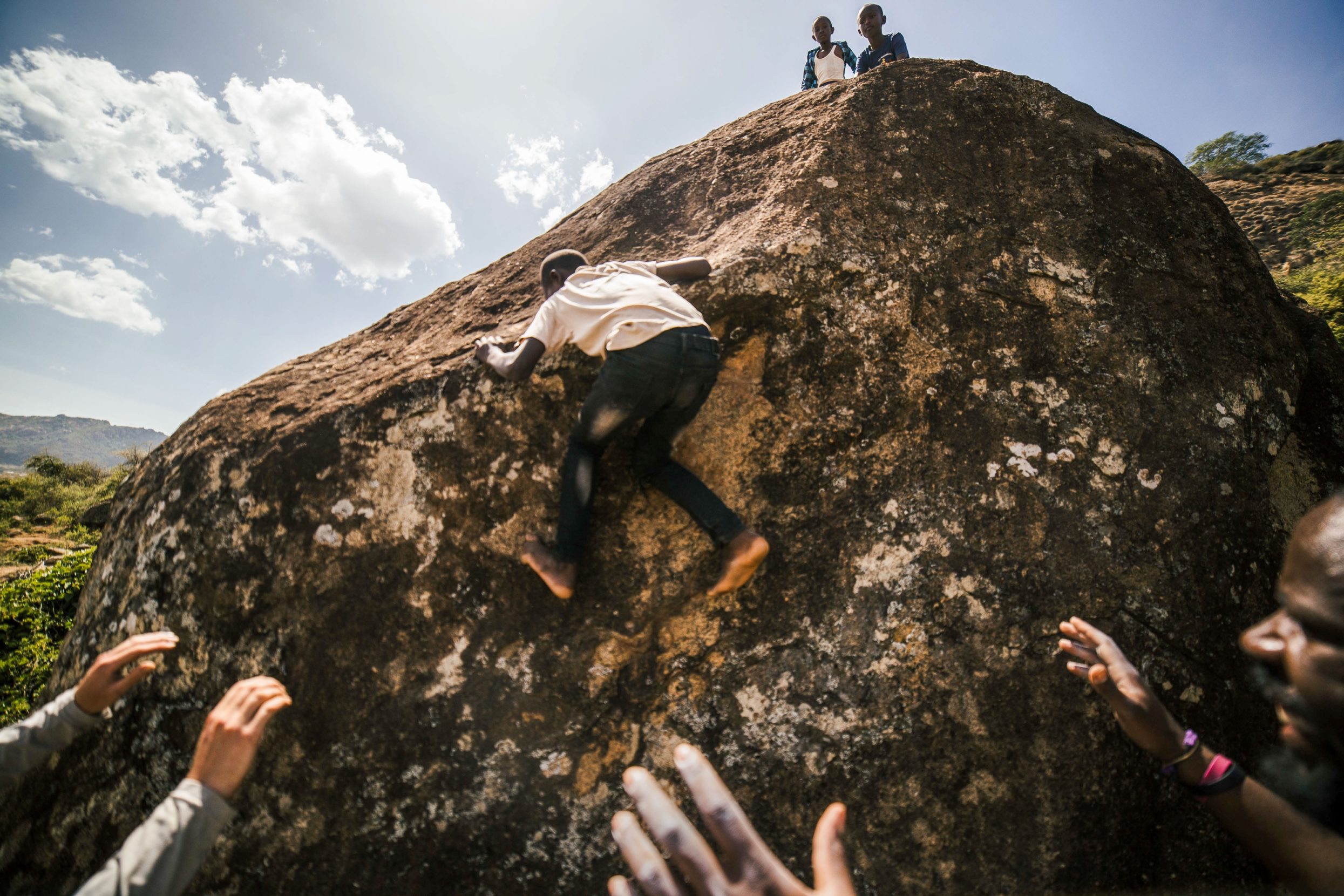
Until recently, rock climbing in Kenya was mostly an activity for expats and foreign visitors. Over the past few decades, however, it’s gained a foothold among locals — including this intrepid young climber in Kipwa, a village at the base of Mavaloni Mountain, two hours from Nairobi. Photo Kang-Chun Cheng.
I want to come back here in the evening sometime, I remember thinking as we disbanded later in the afternoon, racing to beat Nairobi’s notorious rush-hour traffic. It must be the most beautiful time of day then.
I looked up at the crags around me, beautiful and pristine, just waiting for someone to scale them.
Kang-Chun Cheng
Kang-Chun (KC) Cheng is an environmental photojournalist based in Nairobi, Kenya, reporting on land-use conflicts, the impact of climate change and technology on Indigenous communities, and China-Africa relations.
Never miss a story
Subscribe for new issue alerts.
By submitting this form, you consent to receive updates from Hidden Compass regarding new issues and other ongoing promotions such as workshop opportunities. Please refer to our Privacy Policy for more information.

